Résultats de recherche de titre
Articles 1495121 à 1495140 sur 1497515
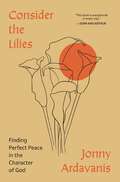
Consider the Lilies: Finding Perfect Peace in the Character of God
Par Jonny Ardavanis. 2024
Find freedom from anxiety as you lift your gaze from the problems and pressures of this world to the changeless…
and powerful character of your heavenly Father.Is my cancer back? Is my job secure? Will I ever get married? Are my children safe? Our lives are often a chronicle of trouble, pain, and uncertainty--and God's children yearn for peace. Many who wrestle with anxiety and despair know that the Bible calls them to "trust God," but what does that even mean?In Consider the Lilies, pastor, podcaster, and speaker Jonny Ardavanis shows us God's consistent response to those who are worn down by worry and badgered by melancholy: He proclaims His own character. Drawing on that perspective-shifting model, Jonny offers biblical insight on how to ground our thoughts and fix our gaze on who God is.Compassionate, biblical, and timely, Consider the Lilies explores:How dwelling on the character of God is the surest pathway to peaceThe root causes of anxiety and worry in the BibleWhat the Bible says about the integration of our physical and spiritual livesWhy worry grieves God's heart as our Father Consider the Lilies is for those who long for liberation from their anxiety and fear--and desire to deeply know the God they are called and enabled to trust. If you are starved for hope and gasping for peace, consider the character of your heavenly Father, who welcomes all who are anxious, fearful, and melancholy to trust in Him.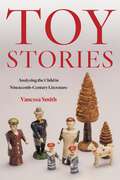
Toy Stories: Analyzing the Child in Nineteenth-Century Literature
Par Vanessa Smith. 2023
Toy Stories: Analyzing the Child in Nineteenth-Century Literature explores the stakes of recurrent depictions of children’s violent, damaging, and tenuously…
restorative play with objects within a long nineteenth century of fictional and educational writing. As Vanessa Smith shows us, these scenes of aggression and anxiety cannot be squared with the standard picture of domestic childhood across that period. Instead, they seem to attest to the kinds of enactments of infant distress we would normally associate with post-psychoanalytic modernity, creating a ripple effect in the literary texts that nest them: regressing developmental narratives, giving new value to wooden characters, exposing Realism’s solid objects to odd fracture, and troubling distinctions between artificial and authentic interiority. Toy Stories is the first study to take these scenes of anger and overwhelm seriously, challenging received ideas about both the nineteenth century and its literary forms. Radically re-conceiving nineteenth-century childhood and its literary depiction as anticipating the scenes, theories, and methodologies of early child analysis, Toy Stories proposes a shared literary and psychoanalytic discernment about child’s play that in turn provides a deep context for understanding both the “development” of the novel and the keen British uptake of Melanie Klein’s and Anna Freud’s interventions in child therapy. In doing so, the book provides a necessary reframing of the work of Klein and Freud and their fractious disagreement about the interior life of the child and its object-mediated manifestations.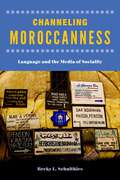
Channeling Moroccanness: Language and the Media of Sociality
Par Becky L. Schulthies. 2021
Honorable Mention, 2022 L. Carl Brown AIMS Book Prize in North African StudiesWhat does it mean to connect as a…
people through mass media? This book approaches that question by exploring how Moroccans engage communicative failure as they seek to shape social and political relations in urban Fez. Over the last decade, laments of language and media failure in Fez have focused not just on social relations that used to be and have been lost but also on what ought to be and had yet to be realized. Such laments have transpired in a range of communication channels, from objects such as devotional prayer beads and remote controls; to interactional forms such as storytelling, dress styles, and orthography; to media platforms like television news, religious stations, or WhatsApp group chats. Channeling Moroccanness examines these laments as ways of speaking that created Moroccanness, the feeling of participating in the ongoing formations of Moroccan relationality. Rather than furthering the discourse about Morocco’s conflict between liberal secularists and religious conservatives, this ethnography shows the subtle range of ideologies and practices evoked in Fassi homes to calibrate Moroccan sociality and political consciousness.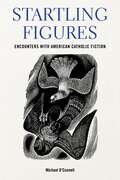
Startling Figures is about Catholic fiction in a secular age and the rhetorical strategies Catholic writers employ to reach a…
skeptical, indifferent, or even hostile audience. Although characters in contemporary Catholic fiction frequently struggle with doubt and fear, these works retain a belief in the possibility for transcendent meaning and value beyond the limits of the purely secular. Individual chapters include close readings of some of the best works of contemporary American Catholic fiction, which shed light on the narrative techniques that Catholic writers use to point their characters, and their readers, beyond the horizon of secularity and toward an idea of transcendence while also making connections between the widely acknowledged twentieth-century masters of the form and their twenty-first-century counterparts.This book is focused both on the aspects of craft that Catholic writers employ to shape the reader’s experience of the story and on the effect the story has on the reader. One recurring theme that is central to both is how often Catholic writers use narrative violence and other, similar disorienting techniques in order to unsettle the reader. These moments can leave both characters within the stories and the readers themselves shaken and unmoored, and this, O’Connell argues, is often a first step toward the recognition, and even possibly the acceptance, of grace. Individual chapters look at these themes in the works of Flannery O’Connor, J. F. Powers, Walker Percy, Tim Gautreaux, Alice McDermott, George Saunders, and Phil Klay and Kirstin Valdez Quade.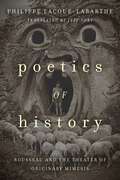
Poetics of History: Rousseau and the Theater of Originary Mimesis
Par Philippe Lacoue-Labarthe. 2019
Rousseau’s opposition to the theater is well known: Far from purging the passions, it serves only to exacerbate them, and…
to render them hypocritical. But is it possible that Rousseau’s texts reveal a different conception of theatrical imitation, a more originary form of mimesis? Over and against Heidegger’s dismissal of Rousseau in the 1930s, and in the wake of classic readings by Jacques Derrida and Jean Starobinski, Lacoue-Labarthe asserts the deeply philosophical importance of Rousseau as a thinker who, without formalizing it as such, established a dialectical logic that would determine the future of philosophy: an originary theatricality arising from a dialectic between “nature” and its supplements.Beginning with a reading of Rousseau’s Discourse on Inequality, Lacoue-Labarthe brings out this dialectic in properly philosophical terms, revealing nothing less than a transcendental thinking of origins. For Rousseau, the origin has the form of a “scene”—that is, of theater. On this basis, Rousseau’s texts on the theater, especially the Letter to d’Alembert, emerge as an incisive interrogation of Aristotle’s Poetics. This can be read not in the false and conventional interpretation of this text that Rousseau had inherited, but rather in relation to its fundamental concepts, mimesis and katharsis, and in Rousseau’s interpretation of Greek theater itself. If for Rousseau mimesis is originary, a transcendental structure, katharsis is in turn the basis of a dialectical movement, an Aufhebung that will translate the word itself (for, as Lacoue-Labarthe reminds us, Aufheben translates katharein). By reversing the facilities of the Platonic critique, Rousseau inaugurates what we could call the philosophical theater of the future.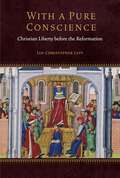
With a Pure Conscience: Christian Liberty before the Reformation (Fordham Series in Medieval Studies)
Par Ian Christopher Levy. 2025
Offers new perspectives on freedom of conscience and religious liberty by tracing their origins to the Middle Ages, thereby challenging…
the common assumption that these core tenets of modernity were products of the EnlightenmentDeeply committed to the formation of a just and sacred society, medieval theologians and canonists developed sophisticated arguments in defense of religious liberty and freedom of conscience. They did so based upon the conviction that each human person possesses an inalienable right to pursue his or her spiritual vocation and to inquire into the truth, provided that such pursuits were not deemed injurious to the commonweal. For this was an age in which all power, whether secular or sacred, was held to be exercised legitimately only insofar as it served the common good. Within these basic parameters there existed a domain of personal freedom guaranteed by natural and divine law that could not be infringed by either secular or ecclesiastical authority. Theologians and canonists did not countenance blind obedience to reigning powers nor did they permit Christians to stand idle in the face of manifest transgressions of sacred tradition, constitutional order, and fundamental human rights.Such foundational principles as the sacred domain of conscience, freedom of intellectual inquiry, dissent from unjust authority, and inalienable personal rights had been carefully developed throughout the later Middle Ages, hence from the twelfth through the fifteenth centuries. Contrary to the popular conception, therefore, the West did not need to wait for the Protestant Reformation, or the Enlightenment, for these values to take hold. In fact, the modern West may owe its greatest debt to the Middle Ages. With a Pure Conscience sheds further light on these matters in a variety of contexts, within and without the medieval university walls, and often amid momentous controversies. This was a robust intellectual culture that revered careful analysis and vigorous disputation in its relentless quest to understand and defend the truth as it could be ascertained through both reason and revelation.With a Pure Conscience: Christian Liberty before the Reformation is available from the Knowledge Unlatched on an open-access basis.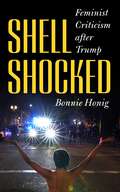
Shell-Shocked: Feminist Criticism after Trump
Par Bonnie Honig. 2021
A biting, funny, up-to-the-minute collection of essays by a major political thinker that gets to the heart of what feminist…
criticism can do in the face of everyday politics.Stormy Daniels offered a #metoo moment, and Anderson Cooper missed it. Conservatives don’t believe that gender is fluid, except when they’re feminizing James Comey. “Gaslighting” is our word for male domination but a gaslight also lights the way for a woman’s survival.Across two dozen trenchant, witty reflections, Bonnie Honig offers a biting feminist account of politics since Trump. In today’s shock politics, Honig traces the continuing work of patriarchy, as powerful, mediocre men gaslight their way across the landscape of democratic institutions.But amid the plundering and patriarchy, feminist criticism finds ways to demand justice. Shell-Shocked shows how women have talked back, acted out, and built anew, exposing the practices and policies of feminization that have historically been aimed not just at women but also at racial and ethnic minorities. The task of feminist criticism—and this is what makes it particularly well-suited to this moment—is to respond to shock politics by resensitizing us to its injustices and honing the empathy needed for living with others in the world as equals. Feminist criticism’s penchant for the particular and the idiosyncratic is part of its power. It is drawn to the loose threads of psychological and collective life, not to the well-worn fabrics with which communities and nations hide their shortcomings and deflect critical scrutiny of their injustices. Taking literary models such as Homer’s Penelope and Toni Morrison’s Cee, Honig draws out the loose threads from the fabric of shock politics’ domination and begins unraveling them. Honig’s damning, funny, and razor sharp essays take on popular culture, national politics, and political theory alike as texts for resensitizing through a feminist lens. Here are insightful readings of film and television, from Gaslight to Bombshell, Unbelievable to Stranger Things, Rambo to the Kavanaugh hearings. In seeking out the details that might break the spell of shock, this groundbreaking book illustrates alternative ways of living and writing in a time of public violence, plunder, and—hopefully—democratic renewal.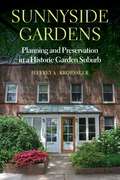
Sunnyside Gardens: Planning and Preservation in a Historic Garden Suburb
Par Jeffrey A. Kroessler. 2021
The first book devoted to this landmark of architecture, urban planning, and social engineeringSituated in the borough of Queens, New…
York, Sunnyside Gardens has been an icon of urbanism and planning since its inception in the 1920s. Not the most beautifully planned community, nor the most elegant, and certainly not the most perfectly preserved, Sunnyside Gardens nevertheless endures as significant both in terms of the planning principles that inspired its creators and in its subsequent history. Why this garden suburb was built and how it has fared over its first century is at the heart of Sunnyside Gardens.Reform-minded architects and planners in England and the United States knew too well the social and environmental ills of the cities around them at the turn of the twentieth century. Garden cities gained traction across the Atlantic before the Great War, and its principles were modified by American pragmatism to fit societal conditions and applied almost as a matter of faith by urban planners for much of the twentieth century. The designers of Sunnyside— Clarence Stein, Henry Wright, Frederick Ackerman, and landscape architect Marjorie Cautley—crafted a residential community intended to foster a sense of community among residents. Richly illustrated throughout with historic and contemporary photographs as well as architectural plans of the houses, blocks, and courts, Sunnyside Gardens first explores the planning of Sunnyside, beginning with the English garden-city movement and its earliest incarnations built around London. Chapters cover the planning and building of Sunnyside and its construction by the City Housing Corporation, the design of the homes and gardens, and the tragedy of the Great Depression, when hundreds of families lost their homes. The second section examine how the garden suburbs outside London have been preserved and how aesthetic regulation is enforced in New York. The history of the preservation of Sunnyside Gardens is discussed in depth, as is the controversial proposal to place the Aluminaire House, an innovative housing prototype from the 1930s, on the only vacant site in the historic district.Sunnyside Gardens pays homage to a time when far-sighted and socially conscious architects and planners sought to build communities, not merely buildings, a spirit that has faded to near-invisibility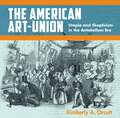
The American Art-Union: Utopia and Skepticism in the Antebellum Era
Par Kimberly A. Orcutt. 2024
The first comprehensive treatment in seventy years of the American Art-Union’s remarkable rise and fallFor over a decade, the New…
York–based American Art-Union shaped art creation, display, and patronage nationwide. Boasting as many as 19,000 members from almost every state, its meteoric rise and its sudden and spectacular collapse still raise a crucial question: Why did such a successful and influential institution fail? The American Art-Union reveals a sprawling and fascinating account of the country’s first nationwide artistic phenomenon, creating a shared experience of visual culture, art news and criticism, and a direct experience with original works.For an annual fee of five dollars, members of the American Art-Union received an engraving after a painting by a notable US artist and the annual publication Transactions (1839–49) and later the monthly Bulletin (1848–53). Most importantly, members’ names were entered in a drawing for hundreds of original paintings and sculptures by most of the era’s best-known artists. Those artworks were displayed in its immensely popular Free Gallery. Unfortunately, the experiment was short-lived. Opposition grew, and a cascade of events led to an 1852 court case that proved to be the Art-Union’s downfall. Illuminating the workings of the American art market, this study fills a gaping lacuna in the history of nineteenth-century US art. Kimberly A. Orcutt draws from the American Art-Union’s records as well as in-depth contextual research to track the organization’s decisive impact that set the direction of the country’s paintings, sculpture, and engravings for well over a decade.Forged in cultural crosscurrents of utopianism and skepticism, the American Art-Union’s demise can be traced to its nature as an attempt to create and control the complex system that the early nineteenth-century art world represented. This study breaks the organization’s activities into their major components to offer a structural rather than chronological narrative that follows mounting tensions to their inevitable end. The institution was undone not by dramatic outward events or the character of its leadership but by the character of its utopianist plan.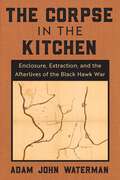
The Corpse in the Kitchen: Enclosure, Extraction, and the Afterlives of the Black Hawk War
Par Adam John Waterman. 2022
Reassessing the archive of the Black Hawk War, The Corpse in the Kitchen explores relationships between the enclosure of Indigenous…
land, histories of resource extraction, and the literary culture of settler colonialism. While conventional histories of the Black Hawk War have long treated the conflict as gratuitous, Adam John Waterman argues that the war part of a struggle over the dispensation of mineral resources specifically, mineral lead—and the emergence of new cultures of killing and composition. The elemental basis for the fabrication of bullets, lead drawn from the mines of the upper Mississippi, contributed to the dispossession of Indigenous peoples through the consolidation of U.S. control over a vital military resource. Rendered as metallic type, Mississippian lead contributed to the expansion of print culture, providing the occasion for literary justifications of settler violence, and promulgating the fiction of Indigenous disappearance.Treating the theft and excarnation of Black Hawk’s corpse as coextensive with processes of mineral extraction, Waterman explores ecologies of racial capitalism as forms of inscription, documentary traces written into the land. Reading the terrestrial in relation to more conventional literary forms, he explores the settler fetishization of Black Hawk’s body, drawing out homoerotic longings that suffuse representations of the man and his comrades. Moving from print to agriculture as modes of inscription, Waterman looks to the role of commodity agriculture in composing a history of settler rapine, including literal and metaphoric legacies of anthropophagy. Traversing mouth and stomach, he concludes by contrasting forms of settler medicine with Black Hawk’s account of medicine as an embodied practice, understood in relation to accounts of dreaming and mourning, processes that are unforgivably slow and that allow time for the imagination of other futures, other ways of being.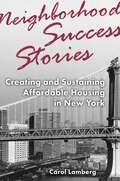
Neighborhood Success Stories: Creating and Sustaining Affordable Housing in New York
Par Carol Lamberg. 2018
The high cost of building affordable housing in New York, and cities like it, has long been a topic of…
urgent debate. Yet despite its paramount importance and the endless work of public and private groups to find ways to provide it, affordable housing continues to be an elusive commodity in New York City—and increasingly so in our current economic and political climate. In a timely, captivating memoir, Carol Lamberg weighs in on this vital issue with the lessons she learned and the successes she won while working with the Settlement Housing Fund, where she was executive director from 1983 until 2014. Lamberg provides a unique perspective on the great changes that have swept the housing arena since the curtailment of the welfare state in the 1970s, and spells out what is needed to address today’s housing problems. In a tradition of “big city” social work memoirs stretching back to Jane Addams, Lamberg reflects on the social purpose, vision, and practical challenges of the projects she’s been involved in, while vividly capturing the life and times of those who engaged in the creation and maintenance of housing and those who have benefited from it. Using a wealth of interviews with managers and residents alike, alongside the author’s firsthand experiences, this book depicts examples of successful community development between 1975 and 1997 in the Bronx and on the Lower East Side of Manhattan. In the “West Bronx Story,” Lamberg details the painful but ultimately exhilarating development of eighteen buildings that comprise New Settlement Apartments—a dramatic transformation of a devastated neighborhood into a thriving community. In “A Tale of Two Bridges,” the author depicts a different path to success, along with its particular challenges. The redevelopment of this area on the Lower East Side involved six different Federal housing programs and consisted of six residential sites, a running track, and a large scale supermarket. To this day, forty years later, all the buildings remain strong. With Neighborhood Success Stories, Lamberg offers a roadmap to making affordable housing a reality with the key ingredients of dogged persistence, group efforts, and creative coalition building. Her powerful memoir provides hope and practical encouragement in times that are more challenging than ever.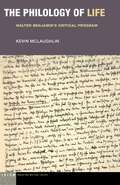
The Philology of Life: Walter Benjamin's Critical Program (Idiom: Inventing Writing Theory)
Par Kevin McLaughlin. 2023
The Philology of Life retraces the outlines of the philological project developed by Walter Benjamin in his early essays on…
Hölderlin, the Romantics, and Goethe. This philological program, McLaughlin shows, provides the methodological key to Benjamin’s work as a whole. According to Benjamin, German literary history in the period roughly following the first World War was part of a wider “crisis of historical experience”—a life crisis to which Lebensphilosophie (philosophy of life) had instructively but insufficiently responded. Benjamin’s literary critical struggle during these years consisted in developing a philology of literary historical experience and of life that is rooted in an encounter with a written image.The fundamental importance of this “philological” method in Benjamin’s work seems not to have been recognized by his contemporary readers, including Theodor Adorno who considered the approach to be lacking in dialectical rigor. This facet of Benjamin’s work was also elided in the postwar publications of his writings, both in German and English. In recent decades, the publication of a wider range of Benjamin’s writings has made it possible to retrace the outlines of a distinctive philological project that starts to develop in his early literary criticism and that extends into the late studies of Baudelaire and Paris. By bringing this innovative method to light this study proposes “the philology of life” as the key to the critical program of one of the most influential intellectual figures in the humanities.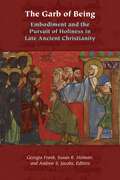
The Garb of Being: Embodiment and the Pursuit of Holiness in Late Ancient Christianity (Orthodox Christianity and Contemporary Thought)
Par Georgia Frank, Susan R. Holman, and Andrew S. Jacobs. 2020
This collection explores how the body became a touchstone for late antique religious practice and imagination. When we read the…
stories and testimonies of late ancient Christians, what different types of bodies stand before us? How do we understand the range of bodily experiences—solitary and social, private and public—that clothed ancient Christians? How can bodily experience help us explore matters of gender, religious identity, class, and ethnicity? The Garb of Being investigates these questions through stories from the Eastern Christian world of antiquity: monks and martyrs, families and congregations, and textual bodies.Contributors include S. Abrams Rebillard, T. Arentzen, S. P. Brock, R. S. Falcasantos , C. M. Furey, S. H. Griffith, R. Krawiec, B. McNary-Zak, J.-N. Mellon Saint-Laurent, C. T. Schroeder, A. P. Urbano, F. M. Young
Medicine at the Margins: EMS Workers in Urban America (Polis: Fordham Series in Urban Studies)
Par Christopher Prener. 2022
Presents a unique view of social problems and conflicts over urban space from the cab of an ambulance.While we imagine…
ambulances as a site for critical care, the reality is far more complicated. Social problems, like homelessness, substance abuse, and the health consequences of poverty, are encountered every day by Emergency Medical Services (EMS) workers. Written from the lens of a sociologist who speaks with the fluency of a former Emergency Medical Technician (EMT), Medicine at the Margins delves deeply into the world of EMTs and paramedics in American cities, an understudied element of our health care system.Like the public hospital, the EMS system is a key but misunderstood part of our system of last resort. Medicine at the Margins presents a unique prism through which urban social problems, the health care system, and the struggling social safety net refract and intersect in largely unseen ways. Author Christopher Prener examines the forms of marginality that capture the reality of urban EMS work and showcases the unique view EMS providers have of American urban life. The rise of neighborhood stigma and the consequences it holds for patients who are assumed by providers to be malingering is critical for understanding not just the phenomenon of non- or sub-acute patient calls but also why they matter for all patients. This sense of marginality is a defining feature of the experience of EMS work and is a statement about the patient population whom urban EMS providers care for daily. Prener argues that the pre-hospital health care system needs to embrace its role in the social safety net and how EMSs’ future is in community practice of paramedicine, a port of a broader mandate of pre-hospital health care. By leaning into this work, EMS providers are uniquely positioned to deliver on the promise of community medicine.At a time when we are considering how to rely less on policing, the EMS system is already tasked with treating many of the social problems we think would benefit from less involvement with law involvement. Medicine at the Margins underscores why the EMS system is so necessary and the ways in which it can be expanded.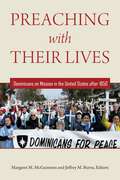
Preaching with Their Lives: Dominicans on Mission in the United States after 1850
Par Margaret M. McGuinness and Jeffrey M. Burns. 2021
This volume tells the little-known story of the Dominican Family—priests, sisters, brothers, contemplative nuns, and lay people—and integrates it into…
the history of the United States. Starting after the Civil War, the book takes a thematic approach through twelve essays examining Dominican contributions to the making of the modern United States by exploring parish ministry, preaching, health care, education, social and economic justice, liturgical renewal and the arts, missionary outreach and contemplative prayer, ongoing internal formation and renewal, and models of sanctity. It charts the effects of the United States on Dominican life as well as the Dominican contribution to the larger U.S. history. When the country was engulfed by wave after wave of immigrants and cities experienced unchecked growth, Dominicans provided educational institutions; community, social, and religious centers; and health care and social services. When epidemic disease hit various locales, Dominicans responded with nursing care and spiritual sustenance. As the United States became more complex and social inequities appeared, Dominicans cried out for social and economic justice. Amidst the ugliness and social dislocation of modern society, Dominicans offered beauty through the liturgical arts, the fine arts, music, drama, and film, all designed to enrich the culture. Through it all, the Dominicans cultivated their own identity as well, undergoing regular self-examination and renewal.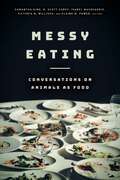
Messy Eating: Conversations on Animals as Food
Par Samantha King, R. Scott Carey, Isabel Macquarrie, Elaine M. Power, Victoria N. Millious. 2019
Literature on the ethics and politics of food and that on human–animal relationships have infrequently converged. Representing an initial step…
toward bridging this divide, Messy Eating features interviews with thirteen prominent and emerging scholars about the connections between their academic work and their approach to consuming animals as food. The collection explores how authors working across a range of perspectives—postcolonial, Indigenous, black, queer, trans, feminist, disability, poststructuralist, posthumanist, and multispecies—weave their theoretical and political orientations with daily, intimate, and visceral practices of food consumption, preparation, and ingestion. Each chapter introduces a scholar for whom the tangled, contradictory character of human–animal relations raises difficult questions about what they eat. Representing a departure from canonical animal rights literature, most authors featured in the collection do not make their food politics or identities explicit in their published work. While some interviewees practice vegetarianism or veganism, and almost all decry the role of industrialized animal agriculture in the environmental crisis, the contributors tend to reject a priori ethical codes and politics grounded in purity, surety, or simplicity. Remarkably free of proscriptions, but attentive to the Eurocentric tendencies of posthumanist animal studies, Messy Eating reveals how dietary habits are unpredictable and dynamic, shaped but not determined by life histories, educational trajectories, disciplinary homes, activist experiences, and intimate relationships. These accessible and engaging conversations offer rare and often surprising insights into pressing social issues through a focus on the mundane—and messy— interactions that constitute the professional, the political, and the personal. Contributors: Neel Ahuja, Billy-Ray Belcourt, Matthew Calarco, Lauren Corman, Naisargi Dave, Maneesha Deckha, María Elena García, Sharon Holland, Kelly Struthers Montford, H. Peter Steeves, Kim TallBear, Sunaura Taylor, Harlan Weaver, Kari Weil, Cary Wolfe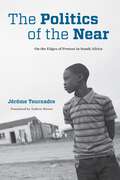
The Politics of the Near: On the Edges of Protest in South Africa (Thinking from Elsewhere)
Par Jérôme Tournadre. 2022
The Politics of the Near offers a novel approach to social unrest in post-apartheid South Africa. Keeping the noise of…
demonstrations, barricades, and clashes with the police at a distance, this ethnography of a poor people’s movement traces individual commitments and the mainsprings of mobilization in the ordinary social and intimate life of activists, their relatives, and other township residents.Tournadre’s approach picks up on aspects of activists lives that are often neglected in the study of social movements that help us better understand the dynamics of protest and the attachment of activists to their organization and its cause. What Tournadre calls a “politics of the near” takes shape, through sometimes innocuous actions and beyond the separation between public and domestic spheres.By mapping the daily life of Black and low-income neighborhoods and the intimate domain where expectations and disappointments surface, The Politics of the Near offers a different perspective on the “rainbow nation”—a perspective more sensitive to the fact that, three decades after the end of apartheid, poverty and race are still as tightly interwoven as ever.
This volume examines the historical connections between the United States’ Reconstruction and the country’s emergence as a geopolitical power a…
few decades later. It shows how the processes at work during the postbellum decade variously foreshadowed, inhibited, and conditioned the development of the United States as an overseas empire and regional hegemon. In doing so, it links the diverse topics of abolition, diplomacy, Jim Crow, humanitarianism, and imperialism.In 1935, the great African American intellectual W. E. B. Du Bois argued in his Black Reconstruction in America that these two historical moments were intimately related. In particular, Du Bois averred that the nation’s betrayal of the South’s fledgling interracial democracy in the 1870s put reactionaries in charge of a country on the verge of global power, with world-historical implications. Working with the same chronological and geographical parameters, the contributors here take up targeted case studies, tracing the biographical, ideological, and thematic linkages that stretch across the postbellum and imperial moments. With an Introduction, eleven chapters, and an Afterword, this volume offers multiple perspectives based on original primary source research. The resulting composite picture points to a host of countervailing continuities and changes. The contributors examine topics as diverse as diplomatic relations with Spain, the changing views of radical abolitionists, African American missionaries in the Caribbean, and the ambiguities of turn-of-the century political cartoons.Collectively, the volume unsettles familiar assumptions about how we should understand the late nineteenth-century United States, conventionally framed as the Gilded Age and Progressive Era. It also advances transnational approaches to understanding America’s Reconstruction and the search for the ideological currents shaping American power abroad.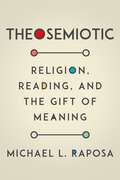
Theosemiotic: Religion, Reading, and the Gift of Meaning
Par Michael L. Raposa. 2020
In Theosemiotic, Michael Raposa uses Charles Peirce’s semiotic theory to rethink certain issues in contemporary philosophical theology and the philosophy…
of religion. He first sketches a history that links Peirce’s thought to that of earlier figures (both within the tradition of American religious thought and beyond), as well as to other classical pragmatists and to later thinkers and developments. Drawing on Peirce’s ideas, Raposa develops a semiotic conception of persons/selves emphasizing the role that acts of attention play in shaping human inferences and perception. His central Peircean presuppositions are that all human experience takes the form of semiosis and that the universe is “perfused” with signs. Religious meaning emerges out of a process of continually reading and re-reading certain signs.Theology is explored here in its manifestations as inquiry, therapy, and praxis. By drawing on both Peirce’s logic of vagueness and his logic of relations, Raposa makes sense out of how we talk about God as personal, and also how we understand the character of genuine communities. An investigation of what Peirce meant by “musement” illuminates the nature and purpose of prayer. Theosemiotic is portrayed as a form of religious naturalism, broadly conceived. At the same time, the potential links between any philosophical theology conceived as theosemiotic and liberation theology are exposed.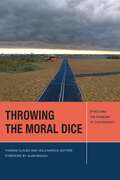
Throwing the Moral Dice: Ethics and the Problem of Contingency (Just Ideas)
Par Thomas Claviez and Viola Marchi. 2022
More than a purely philosophical problem, straddling the ambivalent terrain between necessity and impossibility, contingency has become the very horizon…
of everyday life. Often used as a synonym for the precariousness of working conditions under neoliberalism, for the unknown threats posed by terrorism, or for the uncertain future of the planet itself, contingency needs to be calculated and controlled in the name of the protection of life. The overcoming of contingency is not only called upon to justify questionable mechanisms of political control; it serves as a central legitimating factor for Enlightenment itself. In this volume, nine major philosophers and theorists address a range of questions around contingency and moral philosophy. How can we rethink contingency in its creative aspects, outside the dominant rhetoric of risk and dangerous exposure? What is the status of contingency—as the unnecessary and law-defying—in or for ethics? What would an alternative “ethics of contingency”—one that does not simply attempt to sublate it out of existence—look like?The volume tackles the problem contingency has always posed to both ethical theory and dialectics: that of difference itself, in the difficult mediation between the particular and the universal, same and other, the contingent singularity of the event and the necessary generality of the norms and laws.From deconstruction to feminism to ecological thought, some of today’s most influential thinkers reshape many of the most debated concepts in moral philosophy: difference, agency, community, and life itself.Contributors: Étienne Balibar, Rosi Braidotti, Thomas Claviez, Drucilla Cornell, Hans Ulrich Gumbrecht, Viola Marchi, Michael Naas, Cary Wolfe, Slavoj Žižek